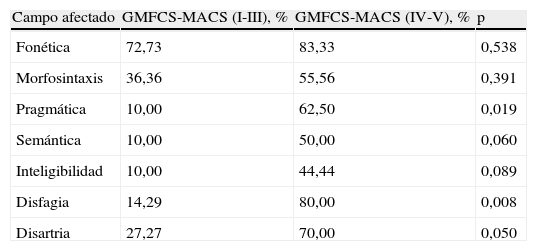La parálisis cerebral (PC) incluye trastornos motores por alteraciones no progresivas en cerebro inmaduro que pueden producir patologías de la comunicación y deglución.
ObjetivosRelacionar la afectación motora de niños con PC con el desarrollo de patologías foniátricas y conocer su evaluación en hospital de tercer nivel.
Material y métodoEstudio descriptivo retrospectivo (7 años) con niños con PC de 4-18 años de edad. Se excluyeron pacientes en etapa preverbal, con déficits sensoriales severos y/o trastornos motores por otras enfermedades. Se recogieron datos demográficos, obstétricos y perinatales, ítems del desarrollo psicomotor, niveles motores y de manipulación medidos con las escalas Gross Motor Functional Classification System (GMFCS) y Manual Ability Classification System (MACS) y patologías foniátricas. Se realizó análisis estadístico en el conjunto de datos y por estratos (puntuación de escalas y valoración/no por foniatra).
ResultadosRevisamos 3.007 historias (n=101 según criterios inclusión; 1,7:1varones). El perfil obstétrico predominante era embarazo normal, bajo peso al nacer y período neonatal con múltiples complicaciones. El nivel cognitivo fue aceptable en el 74,42% (IC 95%, 65,20-83,64%).Un 25,74% (IC 95%, 17,21-34,27%) fue derivado a foniatría. La muestra tenía mayores alteraciones a nivel fonético-fonológico, pero los pacientes con puntuaciones GMFCS-MACS I-III presentaban además múltiples fallos a nivel morfosintáctico y los de GMFCS-MACS IV-V (más afectados en todos los campos medidos) gran prevalencia de disfagia y disartria.
ConclusionesCreemos necesario realizar en niños con PC un screening de comunicación y disfagia desde rehabilitación infantil, apoyándose en resultados de GMFCS y MACS.
Cerebral palsy (CP) includes motor disorders due to non-progressive alterations in an immature brain that may cause communication and swallowing problems.
AimsThe authors have aimed to relate motor conditions of CP children with the development of phoniatrics and to analyze their evaluation in a tertiary hospital.
Material and methodsA retrospective descriptive study (7 years) was conducted with children having CP, with an age range of 4-18 years. Exclusion criteria were patients in the preverbal stage of language, with severe sensorial and/or motor deficits due to other diseases. Data were collected on demographics, obstetrics, psychomotor development, motor and manual ability levels. These were measured with the Gross Motor Functional Classification System (GMFCS) and Manual Ability Classification System (MACS) and phoniatric conditions. A statistical analysis was made of the combined data and by strata (Scale score and evaluation/not specific to speech.
ResultsWe reviewed 3.007 histories (n=101 with inclusion criteria. Males 1.7:1). The most common obstetric profile was normal pregnancy, low birth weight and neonatal period with multiple complications. Cognitive level was described as normal in 74.42% (95% CI, 65.20-83.64%) of the records of the patients. A total of 25.74% (95% CI: 17.21-34.27%) were referred to a Language Unit. The sample showed greater alterations on the phonetic-phonology level. However, patients with GMFCS and MACS I-III scores also had multiple problems on the morphosyntactic level and those with GMFCS-MACS IV-V levels (more affected in all the fields measures) had great prevalence of dysphagia and dysarthria.
ConclusionsWe consider that children with CP should be screened for communication and dsyphagia from child rehabilitation, based on the results of GMFCS and MACS.
Artículo
Comprando el artículo el PDF del mismo podrá ser descargado
Precio 19,34 €
Comprar ahora













